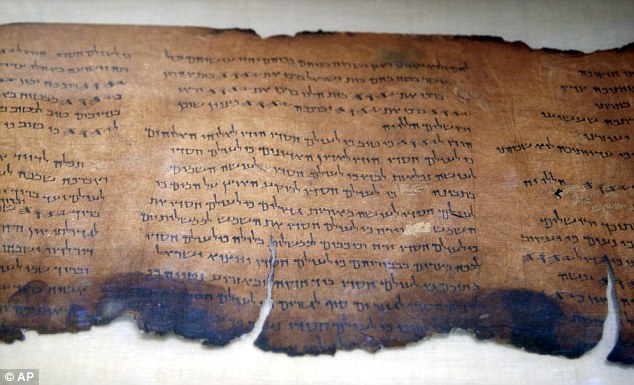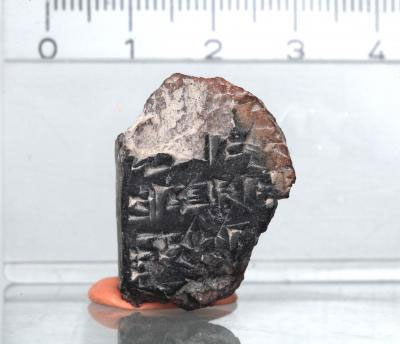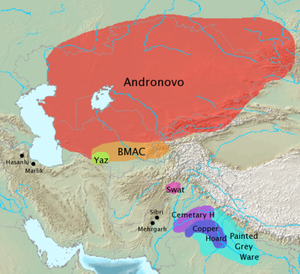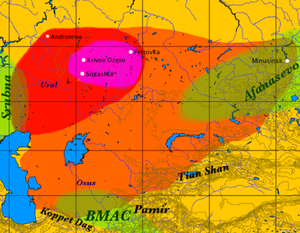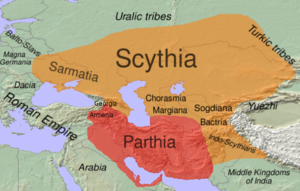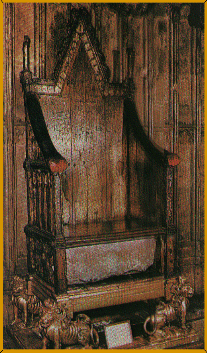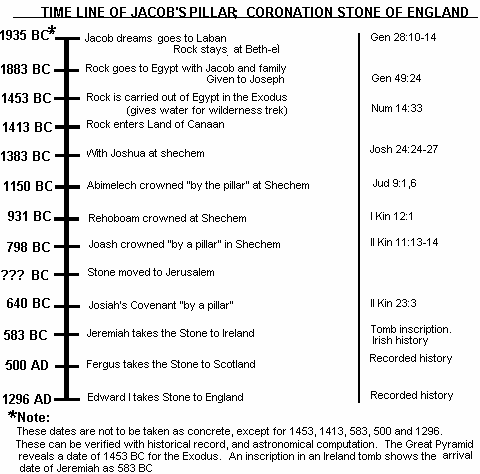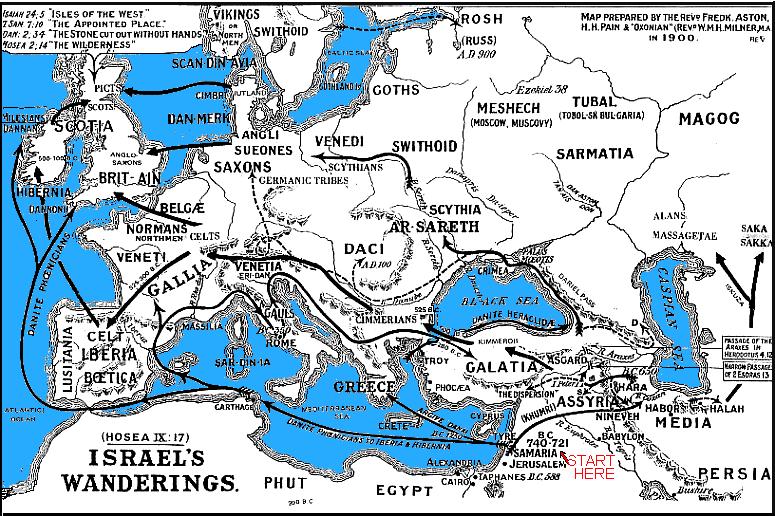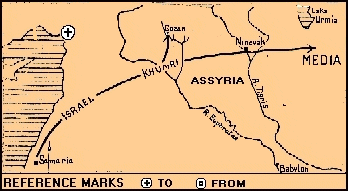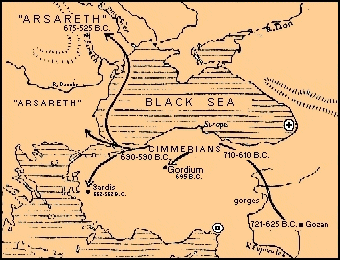- Mar 21, 2010
- 382
- 9
- 0
This makes up 2 sections, its far from a complete short, expanded, PDF & evidentually an Html, with maps, pictures, art, etc ... in sections side by side.
[Theres 5 sections so far and Timeline]
Time Keeping and Biblical Chronology [Add Mythology Mazzoroth Tribe Formations Priest Breastplate as another section]
http://en.wikipedia....antine_calendar
The World era is the common starting point of the astronomical lunar and solar cycles, and of the cycle of indictions, the usual dating system in Byzantium since the 6th century. He also already regards it as the most convenient for the Easter computus. Complex calculations of the 19-year lunar and 28-year solar cycles within this world era allowed scholars to discover the cosmic significance of certain historical dates, such as the birth of Christ or the Crucifixion.
Hours of the liturgical day - In the Byzantine period the day was divided into two 12-hour cycles fixed by the rising and setting of the sun. "Following Roman custom, the Byzantines began their calendrical day (nychthemeron) at midnight with the first hour of day (hemera) coming at dawn. The third hour marked midmorning, the sixth hour noon, and the ninth hour midafternoon. Evening (hespera) began at the 11th hour, and with sunset came the first hour of night (apodeipnon). The interval between sunset and sunrise (nyx) was similarly divided into 12 hours as well as the traditional "watches" (vigiliae) of Roman times."
Days of the liturgical week - Dr. Marcus Rautman points out that the seven-day week was known throughout the ancient world. The Roman Calendar had assigned one of the planetary deities to each day of the week. The Byzantines naturally avoided using these Latin names with their pagan echoes. They began their week with the "Lord's Day" (Kyriake), followed by an orderly succession of numbered days: Deutera ("2nd"), Trite ("3rd"), Tetarte ("4th"), and Pempte ("5th"), a day of "preparation" (Paraskeve), and finally Sabatton. Kyriake was seen as both the first and eighth day of the week, in the same way that Christ was the alpha and omega of the cosmos, existing both before and after time.
Principal considerations for the Byzantine calendar
Genesis creation myth.
Solar cycle (calendar) (28-year solar cycle).
Metonic cycle (19 year lunar cycle).
Indiction (15 year indiction cycle).
Easter Computus. [Venus]
Coptic calendar (March 25, 5493 BC)
Byzantine Church calculation - September 1, 5509 BCE
Roman Theophilus chronology "from the foundation of the world" to emperor Marcus Aurelius 5529 BC
James Ussher (1654) - October 23, 4004 BCE
Britain's Bede in his work "On Time" (703AD) dated creation to 18 March 3952 BC
Judaism - September 22 or March 29, 3760 BCE
http://en.wikipedia....Dating_Creation
Two dominant dates for creation using such models exist, about 5500 BC and about 4000 BC. These were calculated from the genealogies in two versions of the Bible, with most of the difference arising from two versions of Genesis. The older dates are based on the Greek Septuagint. The later dates are based on the Hebrew Masoretic text. The patriarchs from Adam to Terah, the father of Abraham, were often 100 years older when they begat their named son in the Septuagint than they were in the Hebrew or the Vulgate (Genesis 5, 11). The net difference between the two genealogies of Genesis was 1466 years (ignoring the "second year after the flood" ambiguity), which is virtually all of the 1500-year difference between 5500 BCE and 4000 BCE.
For example, the period of Creation to the Flood is derived using the genealogical table of the ten patriarchs listed in Genesis 5, and 7:6, called the generations of Adam. According to the Masoretic Text, this period consists of 1,656 years, and this dating is also followed by Western Christian Bibles derived from the Latin Vulgate. However, according to the Samaritan texts the period is 1,307 years, and according to the Septuagint (Codex Alexandrinus, Elizabeth Bible) it is 2,262 years
http://en.wikipedia....wiki/Anno_Mundi
http://en.wikipedia....ne_of_the_Bible
The chronology of the Bible is the elaborate system of genealogies, generations, reign-periods, and other means by which Hebrew Bible measures the passage of time and thus give a chronological framework to biblical history from the Creation until the historical kingdoms of Israel and Judah.
The "Masoretic" AM dates given below are those traditionally used by Rabbinic Judaism and found in Seder Olam Rabbah. The Gregorian date of Creation is generally given as 3761 BCE, based on the Jewish reckoning. However, a year of 3925 BCE is sometimes given. The deviation of about 163 years is explained in the article Missing years (Jewish calendar).
The "Septuagint" AM dates are based on the Byzantine World Era (based on the Septuagint), which placed the date of creation on the 1st of September in 5509 BCE (to the Julian Calendar).
Chronology - Timeline of the Biblical Patriarchs
http://www.spiritres..._Patriarchs.htm
There are three main texts of the Old Testament, each giving a different chronology.
1. Septuagint [- LXX]
a Greek translation of the Old Testament made in the third century BC. It is so named because it was made by 70 men, or by some accounts 72 with 6 from each tribe. According to legend, these scholars worked independently and produced translations that miraculously agreed verbatim. It was universally regarded by Christians and Jews alike as the Old Testament until several centuries after Christ. The writers of the New Testament reled on it and often quoted it verbatim, and chronologists based their ancient dates upon it. Then the Jews, disliking its association with Christianity, retranslated it to be less favorable to Christianity and gradually abandoned it. Western Christians began using the Latin Vulgate, based on Hebrew rather than Greek texts, as variations began toChristianity and gradually abandoned it. Western Christians began using the Latin Vulgate, based on Hebrew rather than Greek texts, as variations began to creep into the copies of the Septuagint, but Eastern Christians, who spoke Greek for centuries more, continued using the Septuagint.
2. Samaritan [-
an obscure and relatively uninfluential Hebrew text of the Pentateuch (first 5 Old Testament books) preserved quite independently by the Jews of Samaria who arrived just after the northern kingdom was captured and carried away. These Samaritans rejected the authority of the southern kingdom of Judah and all the scriptures after the Pentateuch, and thus we have their separate version.
3. Masoretic [- MSS]
a Hebrew text meticulously compiled by Jewish scholars between the sixth and tenth centuries, with numerous devices to ensure that no transcriptive error could go undetected. Most Western Bibles, including the King James, have been translated from the Masoretic text or from St. Jerome's Latin Vulgate, which in turn drew mainly from it. The Jews consider this text to be the true, original Old Testament, and most modern scholars are strongly biased in its favor, despite the millennium of precedence of the Septuagint. It is said that these Hebrew scriptures were smuggled out of Jerusalem during the Roman siege of AD 70 by a priest hiding in a coffin, and when he escaped they were later copied and compiled for the first time into the modern Old Testament, with the apocrypha rejected as non-canonical and removed.
Where to find this data in Genesis
Adam to Noah, Gen. 5:1-32
Noah to Shem, Gen. 5:32, 7:6, 8:13, 9:28-29, 11:10
Shem to Terah, Gen. 11:10-26
Terah to Abraham, Gen 11:26, 11:32 (cf. Gen. 12:4, Acts 7:4)
Abraham, Gen. 16:16, 17:17, 21:5, 25:7
Isaac, Gen. 21:5, 25:26, 35:28
Jacob, Gen. 25:26, 47:28
[Some Considerations]
Methuselah: Other LXX texts give F = 167, but if his were correct, he would have died 14 years after the Flood.
Noah: Regarding the extra 2 years, compare Genesis 5:32, 7:6, and 11:10.
Arphachshad: Other LXX texts give L = 535 or 565.
Cainan: He is omitted from the [Samaritan & Masoretic Texts], [referenced in] Luke 3:36.
Eber: Other LXX texts give L = 404.
Nahor: Other LXX texts give F = 179, L = 304.
Terah is variously given as 70 or 130 (with corresponding change in L). 130 has historically been favored, but a majority of modern scholars favor 70.
There are of course still other variations within each text. It is assumed that there is no cumulative error from rounding ages to a whole year (or perhaps in some cases to the nearest 5 or 10 years). Old Testament chronology is used as a basis for calculating the age of the world, reckoning dates from creation are said to be anno mundi (AM), or in the year of the world, on the model of anno domini (AD), in the year of the Lord. In Latin years are numbered beginning with 1, so that 1 BC is immediately followed by AD 1. Among these many computations, the following BC dates for the creation have gained popular acceptance:
3760 BC Jewish Era (Tevit) (based on Masoretic) [Low Chronology]
4004 BC Ussher (based on Masoretic) [Samaritan like Dating - Middle Chronology]
5499 BC Africanus, Sextus Julius (3rd century AD),
5501 BC Hippolytus of Thebes (based on Septuagint)
5508 BC Byzantine Era (based on Septuagint) [High Chronology]
The chronology of the Biblical patriarchs, from Adam to Jacob, according to each of these three texts is given in the following table.
[Septuagint versions vary using Alexandrine text]
L = [Age] length of life.
F = [Age of begetting, fatherhood, birth] of next patriarch
B = Birth (anno mundi) [High, Mid, Low Chronology]
D = Death (anno domini) [High, Mid, Low Chronology] {* Change Mundi to Domini *}
Swing Draft Septuagent Samaritan Masoretic
Patriarch
Stuff Goes Here ->
[All Versions are compared against, but from the time Jesse begets David circa 1071 to the time of Hezekiah about 700 BC the Masoretic or Low Chronology is used. Ussher, Samaritan & Middle Chronology is used from the periods of Samuel, Saul & David to the Merneptah Steele circa 1209, forward then to the Early Judges, the Tribes in the Widerness Period, ending in a brief period of revolt (1476) to an Exodus around 1453-1426 BC. Any Time Approxiamately Dating to the Hyksos Period is a Mix of Septuagent, Samaritan & Masoretic]
A Timeline of Bronze to Iron History.rtf
Dark Bronze to Middle Iron Age ... Expanded Version 00
[Swing Draft for High, Mid & Low Chrono's]
(A Good Division of Times, Peoples, Places)
Late Bronze to Early Iron Man Age (1645-700)
k. Dark Bronze Age 1645-1400 (245 years) [Mostly Circa like Dating, Some Dates vary widely between High, Middle and Low Chronologies]
k. Late Bronze Age 1399-1180 (219 years) [Many Dates vary between High, Middle and Low Chronology; The Most Confused Time, Aged-Wise]
k. Early Iron Aged 1179-0936 (243 years) [Dates moderately taper down from High to Low Chronologies varying just a few years at the end]
k. Middle Iron Age 0935-0700 (235 years) [Dates correspond more closely to the year; High, Middle and Low Chronology match more closely]
http://en.wikipedia....s_and_artifacts)
Middle Bronze MB III = 1750–1550 BC (formerly MB IIC)
Late Bronze (LB) Age = 1550–1200 BC
Late Bronze LB I = 1550–1400 BC
Late Bronze LB II = 1400–1200 BC
Iron Age: 1200-586 BC
Iron Age Iron I = 1200–1000 BC
Iron Age Iron IIA = 1000-930 BC
Iron Age Iron IIB = 930-721 BC
Iron Age Iron IIC = 721-586 BC
LEGEND-DATES
a. = Approxiamate Dating
b. = Relative Bible Chronology
c. = Circa, ca, Datings
k. = My Added Datings
x. = Had no Circa Dating
" [] = My Comments "
Late Bronze Age 1399-1180 (219) [Many Dates vary between High, Middle and Low Chronology; The Most Confused Time, Aged-Wise]
x. 1278 BC—Ramesses II defeats the Shardana sea pirates.
x. 1274 the Battle of Kadesh Ramesses II later attempted unsuccessfully to alter this situation in his fifth regnal year by launching an attack on Kadesh in his Second Syrian campaign in 1274 BC, and was caught in history's first recorded military ambush, but thanks to the arrival of the Ne'arin, Ramesses was able to rally his troops and turn the tide of battle against the Hittites. Ramesses II later profited from the Hittites' internal difficulties during his eighth and ninth regnal years, when he campaigned against their Syrian possessions, capturing Kadesh and portions of Southern Syria, and advancing as far north as Tunip where no Egyptian soldier had been seen for 120 years. He ultimately accepted that a campaign against the Hittites was an unsupportable drain on Egypt's treasury and military.[4] In his 21st regnal year, Ramesses signed the first recorded peace treaty with Urhi-Teshub's successor, Hattusili III and with that act Egypt-Hittite relations improved significantly. Ramesses II even married two Hittite princesses, the first after his second Sed Festival.
x. 1274 BC-The Battle of Kadesh (or Battle of Qadesh) in Syria, regarded as the largest (5–6,000) chariot vs. chariot battle in antiquity. The end of the Battle of Kadesh was followed by some 15 years of border warfare ended by the signing of the earliest known peace treaty between the Hittites and Egyptians, the Treaty of Qadesh.
x. 1274 BC-Shalmaneser I becomes King of the Assyrian Empire.
a. 1267 BC-One of the three estimated dates of the Birth of Herakles in Thebes, Greece.
c. 1263 BC—Ramses II, king of ancient Egypt, and Hattusilis III, king of the Hittites, sign the earliest known peace treaty.
x. 1263 BC—The approximate date traditionally offered for the Exodus of the Israelites from Egypt under the leadership of Moses.
c. 1260–1235 BC Ammittamru II King of Ugarit Contemporary of Bentisina of Amurru, Son of Niqmepa
c. 1259 BC—Ramesses II makes peace agreement with the Hittites (other date is 1263 BC).
b. 1253 BC-Ehud died, judged Israel for 80 years. [Jud 3:29] After Ehud died the children of Israel again did evil in the sight of the Lord. So the Lord sold them into the hand of King Jabin of Canaan who harshly oppressed them for 20 years. [Jud 4:1-3] And after him was Shamgar the son of Anath, which slew of the Philistines six hundred men with an ox goad: and he also delivered Israel. [Jdg 3:31]
x. 1251 BC—September 7, A solar eclipse on this date might mark the birth of legendary Heracles at Thebes, Greece.
x. 1250 BC—Traditional date of the beginning of the Trojan War.
x. 1250 BC—Wu Ding emperor of Shang Dynasty to 1192 BC.
c. 1250 BC—Lion Gate, Mycenae, Greece, are made. Citadel walls are built.
b. 1240 BC-Deborah and Barak judge Israel, military campaigns in Qedesh, according to Judges 4:6–10.
a. 1240 Jael assassinates Sisera, a retreating general who was the enemy of the Israelites, according to Judges 5:23–27.
c. 1235–1225/20 Ibiranu King of Ugarit addressee of the letter of Piha-walwi
b. 1233 BC-After 20 years in bondage to Jabin King of Canaan who harshly oppressed them, Shamgar the son of Anath, who slew 600 Philistines with an ox goad delivered Israel. [Jdg 3:31]
b. 1233 BC-The children of Israel cried out to the Lord, He sends Deborah, a prophetess, who was judging Israel at that time. Deborah, Barak and Jael defeat King Jabin of Canaan and his army. [Jud 4:4-24]
x. 1231 BC—King Telephus of Mysia is born in Arcadia (estimated date of birth).
x. 1230 BC—Battle of Nihriya
x. 1225 BC—Birth of legendary Helen to King Tyndareus of Sparta and his wife Leda. (estimated date).
c. 1225/20 – 1215 BC Niqmaddu III King of Ugarit
x. 1224 BC—Death of Ramesses II of Egypt.
x. 1221 BC—Pharaoh Merneptah defeats a Libyan invasion.
x. 1213–1203 BC—Merneptah Stele makes the earliest recorded mention of Israel.
x. 1212 BC–1202-Merneptah, Pharaoh of the Nineteenth Dynasty of Egypt
x. 1212 BC_1201-19th Dynasty Merneptah (Banenre) Thebes-KV8
x. 1213 BC—Theseus, legendary King of Athens, is deposed and succeeded by Menestheus, great-grandson of Erechtheus and second cousin of Theseus' father Aegeus. Menestheus is reportedly assisted by Castor and Polydeuces of Sparta, who want to reclaim their sister Helen from her first husband Theseus. The latter seeks refuge in Skyros, whose King Lycomedes is an old friend and ally. Lycomedes, however, considers his visitor a threat to the throne and proceeds to assassinate him (though other accounts place these events a decade later, in the 1200s BC).
x. 1213 BC—Ramesses II dies (other date is 1212 BC).
x. 1212 BC—Death of Egyptian Pharaoh Ramesses the Great.
x. 1210 BC—Accession of legendary Magadhan king Subrata of the Brihadrata dynasty.
x. 1209 BC-Merneptah Stele
x. 1204 BC—Theseus, legendary King of Athens, is deposed after a reign of 30 years and succeeded by Menestheus, great-grandson of Erichthonius II of Athens and second cousin of Theseus' father Aegeus. Menestheus is reportedly assisted by Castor and Polydeuces of Sparta, who want to reclaim their sister Helen from her first husband Theseus. Theseus seeks refuge in Skyros, whose King Lycomedes is an old friend and ally. Lycomedes, however, considers his visitor a threat to the throne and proceeds to assassinate him. (Other accounts place these events a decade earlier. 1210s BC.)
x. 1202 BC–1199 BC Amenemses, Pharaoh of the 19th Dynasty of Egypt
x. 1201 BC-The 19th dynasty declined as internal fighting between the heirs of Merneptah for the throne increased.
x. 1201 BC_1195-19th Dynasty Seti II (Userkheperure) Thebes-KV15 (consorts Twosret, Takhat)
c. 1200 BC-Ammurapi King of Ugarit Contemporary of Chancellor Bay of Egypt. Ugarit is destroyed. A cuneiform tablet found in 1986 shows that Ugarit was destroyed after the death of Merneptah (1203 BC). It is generally agreed that Ugarit had already been destroyed by the 8th year of Ramesses III (1178 BC). Whether Ugarit was destroyed before or after Hattusa, the Hittite capital, is debated. The destruction is followed by a settlement hiatus. Many other Mediterranean cultures were deeply disordered just at the same time, apparently by invasions of the mysterious "Sea Peoples."
c. 1200 BC-Hazor shows signs of catastrophic fire, and cuneiform tablets found at the site refer to monarchs named Ibni Addi, where Ibni may be the etymological origin of Yavin (Jabin). The city also show signs of having been a magnificent Canaanite city prior to its destruction, with great temples and opulent palaces, split into an upper acropolis, and lower city; the town evidently had been a major Canaanite city. According to the Book of Judges Hazor was the seat of Jabin, the king of Canaan, whose commander, Sisera, led a Canaanite army against Barak [and Deborah]. During the Egyptian Second Intermediate Period and early New Kingdoms (together running between 18th century BC and 13th century BC), Canaan was an Egyptian vassal state; thus 14th century documents, from the El Amarna archive in Egypt, describe the king of Hazor (in Amarna letters called Hasura); specifically report[ing] that Hasura's king has gone over to the Habiru who were invading Canaan. In these documents, Hazor is described as an important city in Canaan. Hazor is also mentioned in the Execration texts, that pre-date the Amarna letters, and in 18th century BCE documents found in Mari on the Euphrates River. Some archaeologists suspect the reason for the destruction of Hazor could be civil strife, attacks by the Sea Peoples, and/or a result of the general collapse of civilisation across the whole eastern Mediterranean in the Late Bronze Age
x. 1200 BC_1196-19th Dynasty Amenmesse (Menmire-Setepenre) Thebes-KV10 apparently usurped the throne from Merneptah's son and successor, Seti II, but he ruled Egypt for only 4 years.
c. 1200 BC—The Cimmerians start settling the steppes of southern Russia? (Undocumented conjecture). [Note: alot of migratory]
x. 1200 BC—Collapse of Hittite power in Anatolia with the destruction of their capital Hattusa.
c. 1200 BC—Start of Iron Age in Middle East
c. 1200 BC—Chariots appear in Ancient China.
c. 1200 BC—Earliest writing that survived exists in Ancient China.
c. 1200 BC—Aramaic Nomads and Chaldeans become a big threat to the former Babylonian and Assyrian Empire.
c. 1200 BC—Massive migrations of people around the Mediterranean and the Middle-East. See Sea People for more information.
c. 1200 BC-Olmec culture starts in Mesoamerica.
c. 1200 BC-San Lorenzo Tenochtitlán starts to flourish.
c. 1200 BC-Chinese Oracle bone script and bronze inscriptions finds.
c. 1200 BC_1000- The Iron Age in the Levant begins, iron tools came into use. It is also known as the Israelite period. This period marks the weakening of regional empires and the strengthening of local powers such as the Kingdom of Israel (in Samaria), Kingdom of Judah, [Phoenicia, Damascus, Trans-Jordanes] and the Philistine city-states.
k. 1200 BC_1100-An ancient well that functioned as a telescope was found at Garlo village, Bulgaria. The device and its function as a welled telescope is analogical to contemporary reflector telescopes used for scientific purposes in observation of the stars (Hubble). The observed object (star or constellation) could be seen through the sky opening in the upper part of the chamber. On the bottom of the chamber just bellow the sky opening there used to a parabolic metal mirror made from copper, silver and or gold. It is possible that the mirror was submerged in water, while the observed object in the sky was reflected. The astronomer then performed his scientific calculations on the radial platform, and through his observation could predict the location and movement of celestial objects throughout the year. Similar wells we can find also in; Keos Island, Greece: The Greek colony of Pantikapei? probably Kerch, Crimea: Tunis: and throughout Sardinia which has approximately 100 wells.
x. 1197 BC—The beginning of first period (1197 BC–982 BC) by Sau Yung's concept of the I Ching and history.
x. 1196 BC- Seti regained power and destroyed most of Amenmesse's monuments. Seti was served at Court by Chancellor Bay, who was originally just a 'royal scribe' but quickly became one of the most powerful men in Egypt gaining the unprecedented privilege of constructing his own tomb in the Valley of the Kings (KV17). Both Bay and Seti's chief wife Twosret reportedly had a sinister reputation in Ancient Egyptian folklore.
x. 1195 BC_1189-19th Dynasty Siptah (Sekhaenre/Akheperre) 1189 - 1187 Thebes-KV47
x. 1194 BC—The beginning of the legendary Trojan War.
b. 1194 BC-Gideon becomes judge
b. 1193 BC-Israel had rest for 40 years, Deborah dies, again the children of Israel did evil in the sight of the Lord. So He delivered them into the hand of Midian for 7 years. [Jud 5:31; 6:1]
x. 1192 BC—Wu Ding king of Shang Dynasty died.
x. 1191 BC—Menestheus, Athens, dies in the Trojan War after a reign of 23 years, succeeded by Demophon, a son of Theseus. (see 1181 BC)
x. 1189 BC_1187-19th Dynasty Queen Twosret (Sitre-MerenamunThebes) KV14 After Siptah's death Twosret ruled Egypt for two more years, but she proved unable to maintain her hold on power amid the conspiracies and powerplays being hatched at the royal court. She was likely ousted in a revolt led by Setnakhte, founder of the Twentieth Dynasty.
x. 1187 BC_1064-Many of the pharaohs of the 20th Dynasty were buried in the Valley of the Kings in Thebes (designated KV). Pharaoh Setnakhte was likely already middle aged when he took the throne after Queen Twosret. He only ruled for a short time when he was succeeded by his son Ramesses III. The period of these rulers is notable for the beginning of the systematic robbing of the Royal Tombs. Many surviving administrative documents from this period are records of investigations and punishment for these crimes, especially in the reigns of Ramses IX and Ramses XI. As happened under the earlier Nineteenth Dynasty, this group struggled under the effects of the bickering between the heirs of Ramesses III.
x. 1187 BC_1185 -20th Dynasty Setnakhte Userkhaure BC Thebes-KV14 Tiy-merenese.
x. 1186 BC—End of the Nineteenth dynasty of Egypt, start of the Twentieth Dynasty.
b. 1186 BC-Israel was greatly impoverished because of the Midianites, and the children of Israel cried out to the Lord. the Lord sent Gideon and he defeated the Midianites with 300 men.
x. 1185 BC_1153--20th Dynasty Ramesses III Thebes KV11 (consort [Iset Ta-Hemdjert] Tiye) Egypt was threatened by the Sea Peoples during this time period, but Ramesses III was able to defeat this confederacy from the Near East [NE??]. The king is also known for a harem conspiracy in which Queen Tiye attempted to assassinate the king and put her son Pentawere on the throne. The coup was not successful in the end. The king may have died from the attempt on his life, but it was his legitimate heir Ramesses IV who succeeded him to the throne. After this a succession of kings named Ramesses take the throne, but none would truly achieve greatness.
x. 1184 BC-April 24, Traditional date of the fall of Troy.
x. 1182 BC-a desperate letter of Ammurapi, the last king of Ugarit, Peoples of the Sea destroy both Ugarit and Alasiya (Cyprus).
x. 1181 BC—Menestheus, legendary king of Athen's in the Trojan War is succeeded by his nephew Demophon, a son of Theseus. (see 1191 BC).
c. 1180 BC—Invaders razed Hattusa causing the collapse of the Hittite Empire
x. 1180 BC—1178 Collapse of the Hittite Empire. Their capital, Hattusa, falls around or slightly after 1180 BC.
Early Iron Age 1179-936 (243) [Dates moderately taper down from High to Low Chronologies varying just a few years at the end]
x. 1178 BC-April 16, A solar eclipse occurs. [Note: @6 years?] This may have marked the return of Odysseus, legendary King of Ithaca, to his kingdom after the Trojan War. He discovers a number of suitors competing to marry his wife Penelope, whom they believe to be a widow, in order to succeed him on the throne. He organizes their slaying and re-establishes himself on the throne. The date is surmised from a passage in Homer's Odyssey, which reads, "The Sun has been obliterated from the sky, and an unlucky darkness invades the world." This happens in the context of a new moon and at noon, both necessary preconditions for a full solar eclipse. In 2008, to investigate, Dr Marcelo O. Magnasco, an astronomer at Rockefeller University, and Constantino Baikouzis, of the Observatorio Astrónomico de La Plata in Argentina, looked for more clues. Within the text, they interpreted three definitive astronomical events: there was a new moon on the day of the slaughter (as required for a solar eclipse); Venus was visible and high in the sky six days before; and the constellations Pleiades and Boötes were both visible at sunset 29 days before. Since these events recur at different intervals, this particular sequence should be unique: the doctors found only one occurrence of this sequence while searching between 1250 and 1115 BC, the 135-year spread around the putative date for the fall of Troy. It coincided with the eclipse of April 16, 1178 BC.
x. 1178 BC-The Battle of Djahy (Canaan) between Ramesses III and the Sea Peoples.
a. 1178 BC-Egyptian decline in power of the New Kingdom and in the Levant during the Bronze Age collapse.
Amurru, Hyksos, Habiru - Just tellin it like it is!
[Theres 5 sections so far and Timeline]
Time Keeping and Biblical Chronology [Add Mythology Mazzoroth Tribe Formations Priest Breastplate as another section]
http://en.wikipedia....antine_calendar
The World era is the common starting point of the astronomical lunar and solar cycles, and of the cycle of indictions, the usual dating system in Byzantium since the 6th century. He also already regards it as the most convenient for the Easter computus. Complex calculations of the 19-year lunar and 28-year solar cycles within this world era allowed scholars to discover the cosmic significance of certain historical dates, such as the birth of Christ or the Crucifixion.
Hours of the liturgical day - In the Byzantine period the day was divided into two 12-hour cycles fixed by the rising and setting of the sun. "Following Roman custom, the Byzantines began their calendrical day (nychthemeron) at midnight with the first hour of day (hemera) coming at dawn. The third hour marked midmorning, the sixth hour noon, and the ninth hour midafternoon. Evening (hespera) began at the 11th hour, and with sunset came the first hour of night (apodeipnon). The interval between sunset and sunrise (nyx) was similarly divided into 12 hours as well as the traditional "watches" (vigiliae) of Roman times."
Days of the liturgical week - Dr. Marcus Rautman points out that the seven-day week was known throughout the ancient world. The Roman Calendar had assigned one of the planetary deities to each day of the week. The Byzantines naturally avoided using these Latin names with their pagan echoes. They began their week with the "Lord's Day" (Kyriake), followed by an orderly succession of numbered days: Deutera ("2nd"), Trite ("3rd"), Tetarte ("4th"), and Pempte ("5th"), a day of "preparation" (Paraskeve), and finally Sabatton. Kyriake was seen as both the first and eighth day of the week, in the same way that Christ was the alpha and omega of the cosmos, existing both before and after time.
Principal considerations for the Byzantine calendar
Genesis creation myth.
Solar cycle (calendar) (28-year solar cycle).
Metonic cycle (19 year lunar cycle).
Indiction (15 year indiction cycle).
Easter Computus. [Venus]
Coptic calendar (March 25, 5493 BC)
Byzantine Church calculation - September 1, 5509 BCE
Roman Theophilus chronology "from the foundation of the world" to emperor Marcus Aurelius 5529 BC
James Ussher (1654) - October 23, 4004 BCE
Britain's Bede in his work "On Time" (703AD) dated creation to 18 March 3952 BC
Judaism - September 22 or March 29, 3760 BCE
http://en.wikipedia....Dating_Creation
Two dominant dates for creation using such models exist, about 5500 BC and about 4000 BC. These were calculated from the genealogies in two versions of the Bible, with most of the difference arising from two versions of Genesis. The older dates are based on the Greek Septuagint. The later dates are based on the Hebrew Masoretic text. The patriarchs from Adam to Terah, the father of Abraham, were often 100 years older when they begat their named son in the Septuagint than they were in the Hebrew or the Vulgate (Genesis 5, 11). The net difference between the two genealogies of Genesis was 1466 years (ignoring the "second year after the flood" ambiguity), which is virtually all of the 1500-year difference between 5500 BCE and 4000 BCE.
For example, the period of Creation to the Flood is derived using the genealogical table of the ten patriarchs listed in Genesis 5, and 7:6, called the generations of Adam. According to the Masoretic Text, this period consists of 1,656 years, and this dating is also followed by Western Christian Bibles derived from the Latin Vulgate. However, according to the Samaritan texts the period is 1,307 years, and according to the Septuagint (Codex Alexandrinus, Elizabeth Bible) it is 2,262 years
http://en.wikipedia....wiki/Anno_Mundi
http://en.wikipedia....ne_of_the_Bible
The chronology of the Bible is the elaborate system of genealogies, generations, reign-periods, and other means by which Hebrew Bible measures the passage of time and thus give a chronological framework to biblical history from the Creation until the historical kingdoms of Israel and Judah.
The "Masoretic" AM dates given below are those traditionally used by Rabbinic Judaism and found in Seder Olam Rabbah. The Gregorian date of Creation is generally given as 3761 BCE, based on the Jewish reckoning. However, a year of 3925 BCE is sometimes given. The deviation of about 163 years is explained in the article Missing years (Jewish calendar).
The "Septuagint" AM dates are based on the Byzantine World Era (based on the Septuagint), which placed the date of creation on the 1st of September in 5509 BCE (to the Julian Calendar).
Chronology - Timeline of the Biblical Patriarchs
http://www.spiritres..._Patriarchs.htm
There are three main texts of the Old Testament, each giving a different chronology.
1. Septuagint [- LXX]
a Greek translation of the Old Testament made in the third century BC. It is so named because it was made by 70 men, or by some accounts 72 with 6 from each tribe. According to legend, these scholars worked independently and produced translations that miraculously agreed verbatim. It was universally regarded by Christians and Jews alike as the Old Testament until several centuries after Christ. The writers of the New Testament reled on it and often quoted it verbatim, and chronologists based their ancient dates upon it. Then the Jews, disliking its association with Christianity, retranslated it to be less favorable to Christianity and gradually abandoned it. Western Christians began using the Latin Vulgate, based on Hebrew rather than Greek texts, as variations began toChristianity and gradually abandoned it. Western Christians began using the Latin Vulgate, based on Hebrew rather than Greek texts, as variations began to creep into the copies of the Septuagint, but Eastern Christians, who spoke Greek for centuries more, continued using the Septuagint.
2. Samaritan [-
an obscure and relatively uninfluential Hebrew text of the Pentateuch (first 5 Old Testament books) preserved quite independently by the Jews of Samaria who arrived just after the northern kingdom was captured and carried away. These Samaritans rejected the authority of the southern kingdom of Judah and all the scriptures after the Pentateuch, and thus we have their separate version.
3. Masoretic [- MSS]
a Hebrew text meticulously compiled by Jewish scholars between the sixth and tenth centuries, with numerous devices to ensure that no transcriptive error could go undetected. Most Western Bibles, including the King James, have been translated from the Masoretic text or from St. Jerome's Latin Vulgate, which in turn drew mainly from it. The Jews consider this text to be the true, original Old Testament, and most modern scholars are strongly biased in its favor, despite the millennium of precedence of the Septuagint. It is said that these Hebrew scriptures were smuggled out of Jerusalem during the Roman siege of AD 70 by a priest hiding in a coffin, and when he escaped they were later copied and compiled for the first time into the modern Old Testament, with the apocrypha rejected as non-canonical and removed.
Where to find this data in Genesis
Adam to Noah, Gen. 5:1-32
Noah to Shem, Gen. 5:32, 7:6, 8:13, 9:28-29, 11:10
Shem to Terah, Gen. 11:10-26
Terah to Abraham, Gen 11:26, 11:32 (cf. Gen. 12:4, Acts 7:4)
Abraham, Gen. 16:16, 17:17, 21:5, 25:7
Isaac, Gen. 21:5, 25:26, 35:28
Jacob, Gen. 25:26, 47:28
[Some Considerations]
Methuselah: Other LXX texts give F = 167, but if his were correct, he would have died 14 years after the Flood.
Noah: Regarding the extra 2 years, compare Genesis 5:32, 7:6, and 11:10.
Arphachshad: Other LXX texts give L = 535 or 565.
Cainan: He is omitted from the [Samaritan & Masoretic Texts], [referenced in] Luke 3:36.
Eber: Other LXX texts give L = 404.
Nahor: Other LXX texts give F = 179, L = 304.
Terah is variously given as 70 or 130 (with corresponding change in L). 130 has historically been favored, but a majority of modern scholars favor 70.
There are of course still other variations within each text. It is assumed that there is no cumulative error from rounding ages to a whole year (or perhaps in some cases to the nearest 5 or 10 years). Old Testament chronology is used as a basis for calculating the age of the world, reckoning dates from creation are said to be anno mundi (AM), or in the year of the world, on the model of anno domini (AD), in the year of the Lord. In Latin years are numbered beginning with 1, so that 1 BC is immediately followed by AD 1. Among these many computations, the following BC dates for the creation have gained popular acceptance:
3760 BC Jewish Era (Tevit) (based on Masoretic) [Low Chronology]
4004 BC Ussher (based on Masoretic) [Samaritan like Dating - Middle Chronology]
5499 BC Africanus, Sextus Julius (3rd century AD),
5501 BC Hippolytus of Thebes (based on Septuagint)
5508 BC Byzantine Era (based on Septuagint) [High Chronology]
The chronology of the Biblical patriarchs, from Adam to Jacob, according to each of these three texts is given in the following table.
[Septuagint versions vary using Alexandrine text]
L = [Age] length of life.
F = [Age of begetting, fatherhood, birth] of next patriarch
B = Birth (anno mundi) [High, Mid, Low Chronology]
D = Death (anno domini) [High, Mid, Low Chronology] {* Change Mundi to Domini *}
Swing Draft Septuagent Samaritan Masoretic
Patriarch
Stuff Goes Here ->
[All Versions are compared against, but from the time Jesse begets David circa 1071 to the time of Hezekiah about 700 BC the Masoretic or Low Chronology is used. Ussher, Samaritan & Middle Chronology is used from the periods of Samuel, Saul & David to the Merneptah Steele circa 1209, forward then to the Early Judges, the Tribes in the Widerness Period, ending in a brief period of revolt (1476) to an Exodus around 1453-1426 BC. Any Time Approxiamately Dating to the Hyksos Period is a Mix of Septuagent, Samaritan & Masoretic]
A Timeline of Bronze to Iron History.rtf
Dark Bronze to Middle Iron Age ... Expanded Version 00
[Swing Draft for High, Mid & Low Chrono's]
(A Good Division of Times, Peoples, Places)
Late Bronze to Early Iron Man Age (1645-700)
k. Dark Bronze Age 1645-1400 (245 years) [Mostly Circa like Dating, Some Dates vary widely between High, Middle and Low Chronologies]
k. Late Bronze Age 1399-1180 (219 years) [Many Dates vary between High, Middle and Low Chronology; The Most Confused Time, Aged-Wise]
k. Early Iron Aged 1179-0936 (243 years) [Dates moderately taper down from High to Low Chronologies varying just a few years at the end]
k. Middle Iron Age 0935-0700 (235 years) [Dates correspond more closely to the year; High, Middle and Low Chronology match more closely]
http://en.wikipedia....s_and_artifacts)
Middle Bronze MB III = 1750–1550 BC (formerly MB IIC)
Late Bronze (LB) Age = 1550–1200 BC
Late Bronze LB I = 1550–1400 BC
Late Bronze LB II = 1400–1200 BC
Iron Age: 1200-586 BC
Iron Age Iron I = 1200–1000 BC
Iron Age Iron IIA = 1000-930 BC
Iron Age Iron IIB = 930-721 BC
Iron Age Iron IIC = 721-586 BC
LEGEND-DATES
a. = Approxiamate Dating
b. = Relative Bible Chronology
c. = Circa, ca, Datings
k. = My Added Datings
x. = Had no Circa Dating
" [] = My Comments "
Late Bronze Age 1399-1180 (219) [Many Dates vary between High, Middle and Low Chronology; The Most Confused Time, Aged-Wise]
x. 1278 BC—Ramesses II defeats the Shardana sea pirates.
x. 1274 the Battle of Kadesh Ramesses II later attempted unsuccessfully to alter this situation in his fifth regnal year by launching an attack on Kadesh in his Second Syrian campaign in 1274 BC, and was caught in history's first recorded military ambush, but thanks to the arrival of the Ne'arin, Ramesses was able to rally his troops and turn the tide of battle against the Hittites. Ramesses II later profited from the Hittites' internal difficulties during his eighth and ninth regnal years, when he campaigned against their Syrian possessions, capturing Kadesh and portions of Southern Syria, and advancing as far north as Tunip where no Egyptian soldier had been seen for 120 years. He ultimately accepted that a campaign against the Hittites was an unsupportable drain on Egypt's treasury and military.[4] In his 21st regnal year, Ramesses signed the first recorded peace treaty with Urhi-Teshub's successor, Hattusili III and with that act Egypt-Hittite relations improved significantly. Ramesses II even married two Hittite princesses, the first after his second Sed Festival.
x. 1274 BC-The Battle of Kadesh (or Battle of Qadesh) in Syria, regarded as the largest (5–6,000) chariot vs. chariot battle in antiquity. The end of the Battle of Kadesh was followed by some 15 years of border warfare ended by the signing of the earliest known peace treaty between the Hittites and Egyptians, the Treaty of Qadesh.
x. 1274 BC-Shalmaneser I becomes King of the Assyrian Empire.
a. 1267 BC-One of the three estimated dates of the Birth of Herakles in Thebes, Greece.
c. 1263 BC—Ramses II, king of ancient Egypt, and Hattusilis III, king of the Hittites, sign the earliest known peace treaty.
x. 1263 BC—The approximate date traditionally offered for the Exodus of the Israelites from Egypt under the leadership of Moses.
c. 1260–1235 BC Ammittamru II King of Ugarit Contemporary of Bentisina of Amurru, Son of Niqmepa
c. 1259 BC—Ramesses II makes peace agreement with the Hittites (other date is 1263 BC).
b. 1253 BC-Ehud died, judged Israel for 80 years. [Jud 3:29] After Ehud died the children of Israel again did evil in the sight of the Lord. So the Lord sold them into the hand of King Jabin of Canaan who harshly oppressed them for 20 years. [Jud 4:1-3] And after him was Shamgar the son of Anath, which slew of the Philistines six hundred men with an ox goad: and he also delivered Israel. [Jdg 3:31]
x. 1251 BC—September 7, A solar eclipse on this date might mark the birth of legendary Heracles at Thebes, Greece.
x. 1250 BC—Traditional date of the beginning of the Trojan War.
x. 1250 BC—Wu Ding emperor of Shang Dynasty to 1192 BC.
c. 1250 BC—Lion Gate, Mycenae, Greece, are made. Citadel walls are built.
b. 1240 BC-Deborah and Barak judge Israel, military campaigns in Qedesh, according to Judges 4:6–10.
a. 1240 Jael assassinates Sisera, a retreating general who was the enemy of the Israelites, according to Judges 5:23–27.
c. 1235–1225/20 Ibiranu King of Ugarit addressee of the letter of Piha-walwi
b. 1233 BC-After 20 years in bondage to Jabin King of Canaan who harshly oppressed them, Shamgar the son of Anath, who slew 600 Philistines with an ox goad delivered Israel. [Jdg 3:31]
b. 1233 BC-The children of Israel cried out to the Lord, He sends Deborah, a prophetess, who was judging Israel at that time. Deborah, Barak and Jael defeat King Jabin of Canaan and his army. [Jud 4:4-24]
x. 1231 BC—King Telephus of Mysia is born in Arcadia (estimated date of birth).
x. 1230 BC—Battle of Nihriya
x. 1225 BC—Birth of legendary Helen to King Tyndareus of Sparta and his wife Leda. (estimated date).
c. 1225/20 – 1215 BC Niqmaddu III King of Ugarit
x. 1224 BC—Death of Ramesses II of Egypt.
x. 1221 BC—Pharaoh Merneptah defeats a Libyan invasion.
x. 1213–1203 BC—Merneptah Stele makes the earliest recorded mention of Israel.
x. 1212 BC–1202-Merneptah, Pharaoh of the Nineteenth Dynasty of Egypt
x. 1212 BC_1201-19th Dynasty Merneptah (Banenre) Thebes-KV8
x. 1213 BC—Theseus, legendary King of Athens, is deposed and succeeded by Menestheus, great-grandson of Erechtheus and second cousin of Theseus' father Aegeus. Menestheus is reportedly assisted by Castor and Polydeuces of Sparta, who want to reclaim their sister Helen from her first husband Theseus. The latter seeks refuge in Skyros, whose King Lycomedes is an old friend and ally. Lycomedes, however, considers his visitor a threat to the throne and proceeds to assassinate him (though other accounts place these events a decade later, in the 1200s BC).
x. 1213 BC—Ramesses II dies (other date is 1212 BC).
x. 1212 BC—Death of Egyptian Pharaoh Ramesses the Great.
x. 1210 BC—Accession of legendary Magadhan king Subrata of the Brihadrata dynasty.
x. 1209 BC-Merneptah Stele
x. 1204 BC—Theseus, legendary King of Athens, is deposed after a reign of 30 years and succeeded by Menestheus, great-grandson of Erichthonius II of Athens and second cousin of Theseus' father Aegeus. Menestheus is reportedly assisted by Castor and Polydeuces of Sparta, who want to reclaim their sister Helen from her first husband Theseus. Theseus seeks refuge in Skyros, whose King Lycomedes is an old friend and ally. Lycomedes, however, considers his visitor a threat to the throne and proceeds to assassinate him. (Other accounts place these events a decade earlier. 1210s BC.)
x. 1202 BC–1199 BC Amenemses, Pharaoh of the 19th Dynasty of Egypt
x. 1201 BC-The 19th dynasty declined as internal fighting between the heirs of Merneptah for the throne increased.
x. 1201 BC_1195-19th Dynasty Seti II (Userkheperure) Thebes-KV15 (consorts Twosret, Takhat)
c. 1200 BC-Ammurapi King of Ugarit Contemporary of Chancellor Bay of Egypt. Ugarit is destroyed. A cuneiform tablet found in 1986 shows that Ugarit was destroyed after the death of Merneptah (1203 BC). It is generally agreed that Ugarit had already been destroyed by the 8th year of Ramesses III (1178 BC). Whether Ugarit was destroyed before or after Hattusa, the Hittite capital, is debated. The destruction is followed by a settlement hiatus. Many other Mediterranean cultures were deeply disordered just at the same time, apparently by invasions of the mysterious "Sea Peoples."
c. 1200 BC-Hazor shows signs of catastrophic fire, and cuneiform tablets found at the site refer to monarchs named Ibni Addi, where Ibni may be the etymological origin of Yavin (Jabin). The city also show signs of having been a magnificent Canaanite city prior to its destruction, with great temples and opulent palaces, split into an upper acropolis, and lower city; the town evidently had been a major Canaanite city. According to the Book of Judges Hazor was the seat of Jabin, the king of Canaan, whose commander, Sisera, led a Canaanite army against Barak [and Deborah]. During the Egyptian Second Intermediate Period and early New Kingdoms (together running between 18th century BC and 13th century BC), Canaan was an Egyptian vassal state; thus 14th century documents, from the El Amarna archive in Egypt, describe the king of Hazor (in Amarna letters called Hasura); specifically report[ing] that Hasura's king has gone over to the Habiru who were invading Canaan. In these documents, Hazor is described as an important city in Canaan. Hazor is also mentioned in the Execration texts, that pre-date the Amarna letters, and in 18th century BCE documents found in Mari on the Euphrates River. Some archaeologists suspect the reason for the destruction of Hazor could be civil strife, attacks by the Sea Peoples, and/or a result of the general collapse of civilisation across the whole eastern Mediterranean in the Late Bronze Age
x. 1200 BC_1196-19th Dynasty Amenmesse (Menmire-Setepenre) Thebes-KV10 apparently usurped the throne from Merneptah's son and successor, Seti II, but he ruled Egypt for only 4 years.
c. 1200 BC—The Cimmerians start settling the steppes of southern Russia? (Undocumented conjecture). [Note: alot of migratory]
x. 1200 BC—Collapse of Hittite power in Anatolia with the destruction of their capital Hattusa.
c. 1200 BC—Start of Iron Age in Middle East
c. 1200 BC—Chariots appear in Ancient China.
c. 1200 BC—Earliest writing that survived exists in Ancient China.
c. 1200 BC—Aramaic Nomads and Chaldeans become a big threat to the former Babylonian and Assyrian Empire.
c. 1200 BC—Massive migrations of people around the Mediterranean and the Middle-East. See Sea People for more information.
c. 1200 BC-Olmec culture starts in Mesoamerica.
c. 1200 BC-San Lorenzo Tenochtitlán starts to flourish.
c. 1200 BC-Chinese Oracle bone script and bronze inscriptions finds.
c. 1200 BC_1000- The Iron Age in the Levant begins, iron tools came into use. It is also known as the Israelite period. This period marks the weakening of regional empires and the strengthening of local powers such as the Kingdom of Israel (in Samaria), Kingdom of Judah, [Phoenicia, Damascus, Trans-Jordanes] and the Philistine city-states.
k. 1200 BC_1100-An ancient well that functioned as a telescope was found at Garlo village, Bulgaria. The device and its function as a welled telescope is analogical to contemporary reflector telescopes used for scientific purposes in observation of the stars (Hubble). The observed object (star or constellation) could be seen through the sky opening in the upper part of the chamber. On the bottom of the chamber just bellow the sky opening there used to a parabolic metal mirror made from copper, silver and or gold. It is possible that the mirror was submerged in water, while the observed object in the sky was reflected. The astronomer then performed his scientific calculations on the radial platform, and through his observation could predict the location and movement of celestial objects throughout the year. Similar wells we can find also in; Keos Island, Greece: The Greek colony of Pantikapei? probably Kerch, Crimea: Tunis: and throughout Sardinia which has approximately 100 wells.
x. 1197 BC—The beginning of first period (1197 BC–982 BC) by Sau Yung's concept of the I Ching and history.
x. 1196 BC- Seti regained power and destroyed most of Amenmesse's monuments. Seti was served at Court by Chancellor Bay, who was originally just a 'royal scribe' but quickly became one of the most powerful men in Egypt gaining the unprecedented privilege of constructing his own tomb in the Valley of the Kings (KV17). Both Bay and Seti's chief wife Twosret reportedly had a sinister reputation in Ancient Egyptian folklore.
x. 1195 BC_1189-19th Dynasty Siptah (Sekhaenre/Akheperre) 1189 - 1187 Thebes-KV47
x. 1194 BC—The beginning of the legendary Trojan War.
b. 1194 BC-Gideon becomes judge
b. 1193 BC-Israel had rest for 40 years, Deborah dies, again the children of Israel did evil in the sight of the Lord. So He delivered them into the hand of Midian for 7 years. [Jud 5:31; 6:1]
x. 1192 BC—Wu Ding king of Shang Dynasty died.
x. 1191 BC—Menestheus, Athens, dies in the Trojan War after a reign of 23 years, succeeded by Demophon, a son of Theseus. (see 1181 BC)
x. 1189 BC_1187-19th Dynasty Queen Twosret (Sitre-MerenamunThebes) KV14 After Siptah's death Twosret ruled Egypt for two more years, but she proved unable to maintain her hold on power amid the conspiracies and powerplays being hatched at the royal court. She was likely ousted in a revolt led by Setnakhte, founder of the Twentieth Dynasty.
x. 1187 BC_1064-Many of the pharaohs of the 20th Dynasty were buried in the Valley of the Kings in Thebes (designated KV). Pharaoh Setnakhte was likely already middle aged when he took the throne after Queen Twosret. He only ruled for a short time when he was succeeded by his son Ramesses III. The period of these rulers is notable for the beginning of the systematic robbing of the Royal Tombs. Many surviving administrative documents from this period are records of investigations and punishment for these crimes, especially in the reigns of Ramses IX and Ramses XI. As happened under the earlier Nineteenth Dynasty, this group struggled under the effects of the bickering between the heirs of Ramesses III.
x. 1187 BC_1185 -20th Dynasty Setnakhte Userkhaure BC Thebes-KV14 Tiy-merenese.
x. 1186 BC—End of the Nineteenth dynasty of Egypt, start of the Twentieth Dynasty.
b. 1186 BC-Israel was greatly impoverished because of the Midianites, and the children of Israel cried out to the Lord. the Lord sent Gideon and he defeated the Midianites with 300 men.
x. 1185 BC_1153--20th Dynasty Ramesses III Thebes KV11 (consort [Iset Ta-Hemdjert] Tiye) Egypt was threatened by the Sea Peoples during this time period, but Ramesses III was able to defeat this confederacy from the Near East [NE??]. The king is also known for a harem conspiracy in which Queen Tiye attempted to assassinate the king and put her son Pentawere on the throne. The coup was not successful in the end. The king may have died from the attempt on his life, but it was his legitimate heir Ramesses IV who succeeded him to the throne. After this a succession of kings named Ramesses take the throne, but none would truly achieve greatness.
x. 1184 BC-April 24, Traditional date of the fall of Troy.
x. 1182 BC-a desperate letter of Ammurapi, the last king of Ugarit, Peoples of the Sea destroy both Ugarit and Alasiya (Cyprus).
x. 1181 BC—Menestheus, legendary king of Athen's in the Trojan War is succeeded by his nephew Demophon, a son of Theseus. (see 1191 BC).
c. 1180 BC—Invaders razed Hattusa causing the collapse of the Hittite Empire
x. 1180 BC—1178 Collapse of the Hittite Empire. Their capital, Hattusa, falls around or slightly after 1180 BC.
Early Iron Age 1179-936 (243) [Dates moderately taper down from High to Low Chronologies varying just a few years at the end]
x. 1178 BC-April 16, A solar eclipse occurs. [Note: @6 years?] This may have marked the return of Odysseus, legendary King of Ithaca, to his kingdom after the Trojan War. He discovers a number of suitors competing to marry his wife Penelope, whom they believe to be a widow, in order to succeed him on the throne. He organizes their slaying and re-establishes himself on the throne. The date is surmised from a passage in Homer's Odyssey, which reads, "The Sun has been obliterated from the sky, and an unlucky darkness invades the world." This happens in the context of a new moon and at noon, both necessary preconditions for a full solar eclipse. In 2008, to investigate, Dr Marcelo O. Magnasco, an astronomer at Rockefeller University, and Constantino Baikouzis, of the Observatorio Astrónomico de La Plata in Argentina, looked for more clues. Within the text, they interpreted three definitive astronomical events: there was a new moon on the day of the slaughter (as required for a solar eclipse); Venus was visible and high in the sky six days before; and the constellations Pleiades and Boötes were both visible at sunset 29 days before. Since these events recur at different intervals, this particular sequence should be unique: the doctors found only one occurrence of this sequence while searching between 1250 and 1115 BC, the 135-year spread around the putative date for the fall of Troy. It coincided with the eclipse of April 16, 1178 BC.
x. 1178 BC-The Battle of Djahy (Canaan) between Ramesses III and the Sea Peoples.
a. 1178 BC-Egyptian decline in power of the New Kingdom and in the Levant during the Bronze Age collapse.
Amurru, Hyksos, Habiru - Just tellin it like it is!


